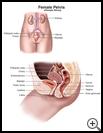
Vaginal Bacteria Overgrowth (Bacterial Vaginosis): Teen Version
________________________________________________________________________
KEY POINTS
- Bacterial vaginosis (BV) is an overgrowth of a certain type of bacteria in the vagina (birth canal). It is a common condition that may or may not cause symptoms.
- Untreated BV may go away on its own. If BV is causing itching, pain, or other problems, you may need antibiotic medicine.
- Ask your healthcare provider if there are activities you should avoid and when you can return to normal activities.
________________________________________________________________________
What is bacterial vaginosis?
Bacterial vaginosis (BV) is an overgrowth of a certain type of bacteria in the vagina (birth canal). It is a common condition that may or may not cause symptoms.
What is the cause?
It’s normal to have some bacteria in the vagina, but sometimes there are too many of certain types of bacteria. Healthcare providers don’t know what causes this imbalance of bacteria. One possible cause is douching (cleaning out the vagina with water or other fluids).
Most cases of bacterial vaginosis happen in sexually active women. Women who have more than 1 sexual partner have a greater risk of this problem. However, women who are not sexually active can also have vaginosis. Smoking cigarettes also increases the risk.
What are the symptoms?
Many women don’t have any symptoms. When women do have symptoms, the most common symptom is a discharge from the vagina. The discharge may be gray or yellowish and smell bad. For example, it may smell fishy, especially after sex. You may also have itching around the opening of the vagina. Sometimes BV can cause pain or burning in the vagina that does not go away.
How is it diagnosed?
Your healthcare provider will ask about your symptoms and medical history. You will have a pelvic exam, and your provider will get a sample of vaginal discharge for lab tests.
How is it treated?
Untreated bacterial vaginosis sometimes goes away on its own. Sometimes, if you scratch the area to relieve itching, you may get an infection. Rarely, it may cause vaginal pain that keeps bothering you. If bacterial vaginosis is causing itching, pain, or other problems, it may need to be treated with antibiotic medicine. The medicine for bacterial vaginosis may be taken by mouth or it may be a cream or gel that you put into the vagina. The symptoms usually go away within a few days after you start treatment.
How can I take care of myself?
Follow your healthcare provider's instructions. Ask your provider:
- How and when you will get your test results
- How long it will take to recover
- If there are activities you should avoid and when you can return to normal activities
- How to take care of yourself at home
- What symptoms or problems you should watch for and what to do if you have them
Make sure you know when you should come back for a checkup. Keep all appointments for provider visits or tests.
How can I help prevent bacterial vaginosis?
- Use latex or polyurethane condoms the right way during foreplay and every time you have vaginal, oral, or anal sex.
- Have just 1 sexual partner who is not sexually active with anyone else and who will use protection every time you have sex.
- If you have had sex and are worried that you may have been infected, see your healthcare provider even if you don’t have any symptoms.
- Do not douche.
Last modified: 2019-10-29
Last reviewed: 2019-08-05

